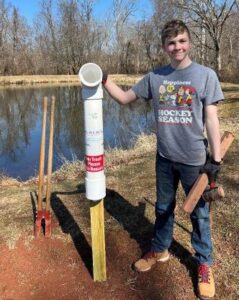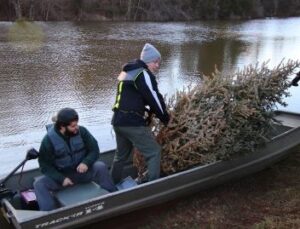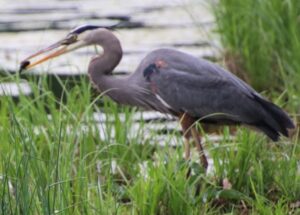 My name is Jason W, and I am an Eagle Scout in Troop 1094 in Darnestown, Maryland. I really enjoy being outside and I really enjoy watching and learning about wildlife. I look forward to becoming a wildlife biologist one day. Back in 2022, I learned about the BSA Distinguished Conservation Service Award (DCSA). The DCSA award is the former Hornaday Award and it encourages Scouts to design, lead, and carry out a conservation project. The project must be designed to address a conservation issue or need in the local area, and it must benefit the environment and the creatures that live there. There are nine conservation project categories to choose from, and you must complete two projects in two different categories. One project may count as your Eagle project. I decided I wanted to earn this award, and my first project, which was also my Eagle project, would be in the category of pollinator habitat conservation. I created a ½ acre pollinator habitat in Poolesville, Maryland, and wrote an article about it last April. After I wrote that article, I was honored to earn the Daughters of the American Revolution National Conservation Service Award and the 2023 Glenn A. and Melinda W. Adams Eagle Scout Service Project of the Year Award for the National Capital Area Council. If you are interested in seeing photos, here is my video link.
My name is Jason W, and I am an Eagle Scout in Troop 1094 in Darnestown, Maryland. I really enjoy being outside and I really enjoy watching and learning about wildlife. I look forward to becoming a wildlife biologist one day. Back in 2022, I learned about the BSA Distinguished Conservation Service Award (DCSA). The DCSA award is the former Hornaday Award and it encourages Scouts to design, lead, and carry out a conservation project. The project must be designed to address a conservation issue or need in the local area, and it must benefit the environment and the creatures that live there. There are nine conservation project categories to choose from, and you must complete two projects in two different categories. One project may count as your Eagle project. I decided I wanted to earn this award, and my first project, which was also my Eagle project, would be in the category of pollinator habitat conservation. I created a ½ acre pollinator habitat in Poolesville, Maryland, and wrote an article about it last April. After I wrote that article, I was honored to earn the Daughters of the American Revolution National Conservation Service Award and the 2023 Glenn A. and Melinda W. Adams Eagle Scout Service Project of the Year Award for the National Capital Area Council. If you are interested in seeing photos, here is my video link.
For my 2nd Distinguished Conservation Service Award Project, I began a three-stage project to improve the fish and wildlife in my hometown of Poolesville, Maryland. The first stage was to hopefully attract a new breed of ducks to Poolesville. More specifically, wood ducks. I installed four nesting boxes at a quiet pond in Poolesville last fall. While I haven’t seen any wood ducks yet, this spring, I was able to witness hooded mergansers (cavity nesters) at this pond and watch tree swallows build nests in the boxes.
My second stage was to build 10 monofilament fishing line recycle bins. I built these bins with three members of my Troop back in December 2023. My purpose was to place nine of them around the ponds of Poolesville. The last one we built was for me to share with the Poolesville Sustainability Committee so they could have one on display at community festivals to promote the recycling of fishing lines. Fishing line takes 600 years to decompose and it is very dangerous to wildlife who get caught up in the discarded fishing line in the water. Just last year, we had a Canadian goose have a bunch of fishing lines tied around its foot that required four people to help him get loose. This fishing line will be collected and sent to a recycling facility in Iowa. Then, it will be melted down into little pellets, which will, in turn, be made into fishing tackle boxes. In February, I installed the nine recycle bins. I waited until May to go around and collect the fishing line. I am happy to report that eight recycling bins were filled with fishing lines. It was a huge collection that is currently on its way to Iowa to be recycled.
 My third stage of the project was a lot of fun. I asked my community to promise to let me collect their Christmas trees after the holiday season. A fellow troop Scout and I drove around town and picked up 30 Christmas trees in January. We learned as we drove around that local farmers also collect Christmas trees to feed their goats. After we collected the trees, I recruited three of my ice hockey teammates to help me wire cinderblocks to these trees. We had to drill holes through the trees, insert the wire through the tree, and then to the cinderblock. Otherwise, the tree will float and not sink. At the end of January, a few scouts, along with my distinguished service conservation advisor, Ms. Sara Holtz, my project conservation advisor, Mr. King, and a few members of his work crew, helped me drop 30 Christmas trees into the deepest pond in Poolesville (Here is my video link of that day if you are interested). This pond is mainly silt at the bottom and lacks a structure for the fish to hide in after spawning. The trees will give cover to the small fish and help them grow larger and survive, hence improving the ecosystem. It has been a lot of fun observing the wildlife at this pond. One day, while holding catch-and-release fishing day with my Troop at the pond, we observed a female bufflehead swimming up and down the line where I dropped the Christmas trees in the water. She was diving under and would then pop up several yards later. This type of duck likes to feed on small minnows. She was finding those minnows in the trees. On another day, I saw this beautiful blue heron that had just caught a small minnow in its beak.
My third stage of the project was a lot of fun. I asked my community to promise to let me collect their Christmas trees after the holiday season. A fellow troop Scout and I drove around town and picked up 30 Christmas trees in January. We learned as we drove around that local farmers also collect Christmas trees to feed their goats. After we collected the trees, I recruited three of my ice hockey teammates to help me wire cinderblocks to these trees. We had to drill holes through the trees, insert the wire through the tree, and then to the cinderblock. Otherwise, the tree will float and not sink. At the end of January, a few scouts, along with my distinguished service conservation advisor, Ms. Sara Holtz, my project conservation advisor, Mr. King, and a few members of his work crew, helped me drop 30 Christmas trees into the deepest pond in Poolesville (Here is my video link of that day if you are interested). This pond is mainly silt at the bottom and lacks a structure for the fish to hide in after spawning. The trees will give cover to the small fish and help them grow larger and survive, hence improving the ecosystem. It has been a lot of fun observing the wildlife at this pond. One day, while holding catch-and-release fishing day with my Troop at the pond, we observed a female bufflehead swimming up and down the line where I dropped the Christmas trees in the water. She was diving under and would then pop up several yards later. This type of duck likes to feed on small minnows. She was finding those minnows in the trees. On another day, I saw this beautiful blue heron that had just caught a small minnow in its beak.

I can proudly say that I’ve fully completed the DCSA! Working on it has been a very hard but very rewarding process. It takes a lot of time and a lot of volunteers to help you succeed. My first project took me about 187 hours to complete, with 69 volunteers for a total of 349 project hours. My second project has taken me about 188 hours to complete with 22 volunteers for a total of 341 project hours. Combined that is a total of 690 volunteer hours of making my local ecosystem a better place for everyone to enjoy. I’m very proud of what my volunteers and I have accomplished. I’m only 16 years old and finishing up my sophomore year of high school. What I have learned the most so far in Scouting is how incredible it is to be a part of something bigger than yourself.

